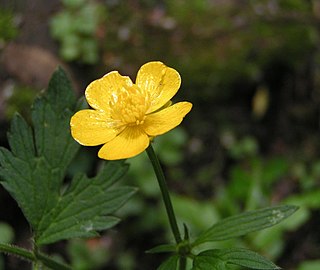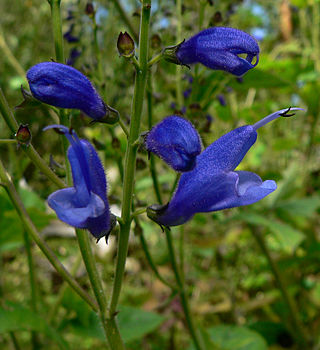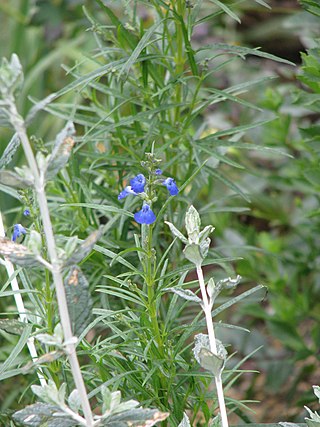
Trifolium repens, the white clover, is a herbaceous perennial plant in the bean family Fabaceae. It is native to Europe, including the British Isles, and central Asia and is one of the most widely cultivated types of clover. It has been widely introduced worldwide as a forage crop, and is now also common in most grassy areas of North America, Australia and New Zealand. The species includes varieties often classed as small, intermediate and large, according to height, which reflects petiole length. The term 'white clover' is applied to the species in general, 'Dutch clover' is often applied to intermediate varieties, and 'ladino clover' is applied to large varieties.

Ranunculus repens, the creeping buttercup, is a flowering plant in the buttercup family Ranunculaceae, native to Europe, Asia and northwestern Africa. It is also called creeping crowfoot and sitfast.

Mitchella repens is the best known plant in the genus Mitchella. It is a creeping prostrate herbaceous woody shrub occurring in North America belonging to the madder family (Rubiaceae).

Elymus repens, commonly known as couch grass, is a very common perennial species of grass native to most of Europe, Asia, the Arctic biome, and northwest Africa. It has been brought into other mild northern climates for forage or erosion control, but is often considered a weed.

Banksia repens, the creeping banksia, is a species of shrub in the plant genus Banksia. It occurs on the south coast of Western Australia from D'Entrecasteaux National Park in the west to Mount Ragged in the east.

Mahonia repens commonly known as creeping mahonia, creeping Oregon grape, creeping barberry, or prostrate barberry, is a species of Mahonia native to the Rocky Mountains and westward areas of North America, from British Columbia and Alberta in the north through Arizona and New Mexico, then into northwest Mexico by some reports. It is also found in many areas of California and the Great Basin region in Nevada.

Stylidium repens, the matted triggerplant, is a dicotyledonous plant that belongs to the genus Stylidium. S. repens is endemic to Australia and is found primarily in southwest Western Australia. This species is a creeping or scrambling triggerplant, which can spread over large areas as a tangled mat of stems and aerial roots. The older stems are grey whereas younger stems appear red and have terminal rosettes of small leaves, five mm to one cm in length. When the rains come, new roots and a one to three flowers emerge from the terminal rosettes. This is the only species of triggerplant known to regularly flower twice a year—in autumn and late spring. Pollination, which is typically very specialized in this genus, is achieved with a variety of insects in this species.

Impatiens repens, the Ceylon balsam, yellow impatiens, or creeping balsam, is a species of flowering plant in the family Balsaminaceae, from Sri Lanka. As the Latin name repens indicates, it is a low-growing plant with a creeping habit. This evergreen perennial can be found in wet-zone rain forests. Growing to 50 cm (20 in) tall and broad, it has small kidney-shaped leaves borne on red stems, and hooded yellow flowers in summer and autumn. It can be seen cultivated in gardens as an ornamental plant. In temperate zones it must be protected from temperatures below 10 °C (50 °F), so must be grown under glass during the winter months, It requires a sheltered position in partial shade.

Ononis repens, the common restharrow, is a flowering plant species in the bean family Fabaceae. The name is synonym of Ononis spinosa subsp. procurrens.

Chelyocarpus is a genus of small to medium-sized fan palms which are native to northwestern South America. Some are upright trees, while others creep along the ground. Species are used for thatch, to weave hats, stuff pillows and as a source of salt.

Salvia cacaliifolia, the blue vine sage or Guatemalan sage, is a species of flowering plant in the family Lamiaceae, native to the mountains of Chiapas, Mexico, and in Guatemala and Honduras, at 1,500–2,500 m (4,921–8,202 ft) elevation. It has been available in the United Kingdom for many years, after being recognized by Irish gardener and journalist William Robinson in 1933. Since the 1970s, it has been available in the United States, after Strybing Arboretum and Huntington Botanical Gardens introduced it to California growers.

Salvia koyamae (Shinano-akigiri) is a perennial rarely found in the wild and native to the Japanese island of Honshu, where it has a close affinity to two other salvia species: Salvia glabrescens and Salvia nipponica. It was named by Tomitaro Makino, considered the "father of Japanese botany".
Salvia namaensis is an evergreen perennial shrub native to a limited area in Namibia and a wide area of South Africa. It is typically found growing on rocky slopes, shales, limestone hills, and sandy soils at 1,000 to 5,000 feet elevation. The specific epithet namaensis probably refers to the Nama tribe which is indigenous to Namaqualand, the region in Namibia where the plant grows.

Salvia reptans is a widely distributed herbaceous perennial native to the mountains of the Trans-Pecos in Texas, and in Mexico and Guatemala. It typically grows in dry stream beds and gravelly soils. It was introduced into horticulture in the 19th century and was previously known as S. angustifolia and S. leptophylla, both of which refer to the slender leaves. The specific epithet reptans refers to the plant's creeping habit.
Salvia roborowskii is an annual or sometimes biennial herb that is native to a wide area that includes Tibet, Sikkim, and five provinces in China, growing on wet stream banks, grasslands, and hillsides between 8,000 and 12,000 feet elevation.
Salvia stenophylla is a perennial shrub native to a wide area of Southern Africa: South Africa, Botswana and Namibia. It grows on grassy or stony slopes, and in open countryside or among shrubs. It has been used traditionally as a disinfectant by burning it in huts after sickness, and it is also mixed with tobacco for smoking. Its specific epithet, stenophylla, refers to the narrow leaves.

Grevillea repens, the creeping grevillea, is a species of flowering plant in the family Proteaceae and is endemic to Victoria, Australia. It is a prostrate, often mat-forming shrub, that has leaves with 5 to 19 teeth or lobes, and light green or grey, toothbrush-like flowers with reddish striations and a deep red, or dull orange to yellow style.

Dichondra repens, commonly known as kidney weed, Mercury Bay weed, tom thumb, or yilibili in the Dharawal language, is a species of flowering plant in the family Convolvulaceae and is native to Australia, New Zealand, and the Indian Ocean islands, Mauritius, Réunion and Rodrigues. It is a perennial, herb with kidney-shaped to round leaves and small, greenish-yellow, star-shaped flowers.

Scaevola repens is a shrub in the family Goodeniaceae, endemic to the south west of Western Australia.

Jovellana repens is an endemic New Zealand plant in the family Calceolariaceae spread through both the North and South Islands. It has small green leaves and white flowers with spots of purple on the inside.
















